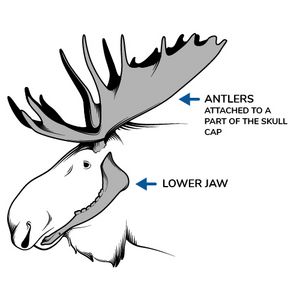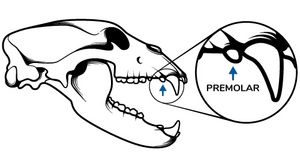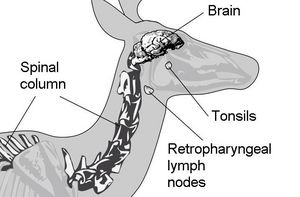General rules
Game transportation and exports
Transportation coupons
When you kill a white-tailed deer, a moose, a black bear or a wild turkey, you must immediately remove the appropriate transportation coupon from your licence and attach it to the animal.
In addition, when you kill an antlerless deer under an antlerless deer hunting licence (random draw) or an adult female moose under an adult female moose hunting licence (random draw), you must immediately punch the random draw licence in the circle provided, no later than at midnight on the day of the harvest.
Special rules apply if you hunt antlerless deer or if you hunt deer as part of a group in a wildlife reserve, outfitter with exclusive rights and certain ZECs, or if you share your licence to hunt female moose in a wildlife reserve.
Additional transportation coupons for moose
If you kill a moose, you must ensure that the required number of additional transportation coupons (i.e. the same as the number of licences required per moose) are attached to the animal on the same day it is killed.
Every additional coupon must come from the hunting licence of an individual:
- who is legally entitled to hunt moose using a permitted weapon, during the period and in the area (zone, outfitter with exclusive rights or ZEC) where the animal was killed, and where moose hunting is subject to quotas; and
- who took part in the hunting expedition during which the moose was killed.
If the moose was killed in a ZEC, all the additional coupons must come from the licences of individuals who, before the animal was killed, had paid the requisite fee to hunt moose in the ZEC, and had registered when entering the ZEC.
During a moose hunt subject to a quota in a wildlife reserve, and regardless of whether the group is a single group or a double group, the person who kills the animal must ensure that another transportation coupon from the hunting licence of a person in the same group is attached to the animal on the day it is killed. The people whose transportation coupons are attached to the animal are then deemed to have reached their annual bag limit for moose.
Transportation coupon of a young person hunting under another licence
In wildlife reserves, a single group of four hunters may accept a fifth hunter, provided he or she is a young person or student (see the section on Bag limits in wildlife reserves). The same applies to a double group of seven or eight hunters, who may accept no more than two additional hunters on the same conditions. If the additional hunter holds a moose hunting licence, he or she may place the transportation coupon from that licence on the animal killed, in the same way as any other group member. If the additional hunter does not have a moose hunting licence and is hunting under the licence of an adult member of the group, he or she will be deemed to have reached his or her moose bag limit and may not participate in the registration of another moose during the current year.
A young hunter who kills a big game animal or a wild turkey under a regular licence must attach the transportation coupon from the licence under which he or she hunted, and must then comply with all subsequent requirements, including registration of the game in his or her name.
When all the transportation coupons from the licence have been removed, neither the young hunter nor the adult licence holder can continue to hunt the animal in question, for the rest of the year. A young hunter who kills an antlerless deer under the antlerless deer hunting licence of an adult must punch the licence in question, no later than at midnight on the day of the harvest, and, in the circle provided, must comply with all subsequent requirements, including registering the antlerless deer in his or her name. Once punched, the privilege to kill an antlerless deer expires, but the licence remains valid to kill a buck if the transportation coupon is still attached to the licence. The same rule applies to a female moose hunting licence.
Species-specific transportation rules
Below are the specific transportation rules applicable to game animals before online registration or during in-person registration. The animal’s condition may be checked by a wildlife protection officer or registration station delegate.
Transporting a moose

When you kill a moose, you must transport and produce it whole or in identifiable quarters at a registration station.
In the case of a moose produced in quarters, you must also produce and make available the whole head, failing which you must produce and make available the full lower jaw and, in the case of a male, the antlers attached to the full or partial calvarium.
Sharing moose flesh with other hunters
After killing a moose and registering it, you may separate the flesh for transportation to your respective butchers.
You must each keep a copy of the proof of registration, so that you are able to confirm the source of the meat if you are asked to do so by a wildlife protection officer or wildlife protection assistant.
Transporting a white-tailed deer

After killing a white-tailed deer, you must transport it to a registration station and produce it whole or in two approximately equal parts separated transversally along the floating ribs or the kidneys, as shown in the diagram.
In addition, if the deer is divided into two parts, you must present both parts without removing the head and the external genital organs (scrotum or vulva) from either part of the animal.
In no case should the skin or hooves be removed from the animal before it is registered.
Transporting a black bear

If you kill a black bear, you must present the carcass or pelt of the animal to an officer upon request, or when registering the animal at a registration station.
To facilitate the management of black bear, hunters are asked, at registration, to provide the two upper premolars (see the diagram) and to indicate the date and exact location of the kill, along with the animal’s gender and the presence or absence of milk.
The premolars are located directly behind the canines. They can easily be removed as follows:
- Use a sharp knife to free the tooth from the gum.
- Thrust the tip of the knife into the gum between the canine and the premolar and dislodge the tooth with a slight twisting motion.
- Do not wash or boil the teeth.
The operation is identical for both premolars. To avoid confusing one animal with another, you should place both teeth and the required information for each black bear in a separate envelope. The premolars are not always apparent in older animals.
Transporting a wild turkey
If you kill a wild turkey, you must transport it and present it whole, eviscerated or not, at a registration station.
Restrictions relating to chronic wasting disease in cervids
The government has introduced measures to protect wild cervid herds and continues to take action to reduce the risk that chronic wasting disease (CWD) will become established in wild populations.
Below are the regulatory restrictions that apply to the transportation of anatomical parts of cervids killed by hunters.
Regulatory restrictions on the transportation of certain anatomical parts within a 45-km radius
The regulation places restrictions on the transportation of certain anatomical parts of cervids (white-tailed deer, moose and farm-raised cervids) killed within a 45-km radius of a site at which CWD has been confirmed (see the map ). It is therefore forbidden to take the anatomical parts in which CWD is concentrated out of the 45-km radius AND out of the hunting zone in which the animal was killed.
Rules governing imports of cervid carcasses
It is forbidden to import or possess whole carcasses and certain anatomical parts of cervids (except caribou) killed outside Québec. In cervids with CWD, pathogenic prions are concentrated in the organs concerned.
If you hunt outside Québec:
- Avoid hunting in or near sectors where CWD has been detected
.
- If the authorities of the province or state where you killed the cervid informs you that the animal has CWD, please notify SOS Poaching – Wildlife Emergency by calling 1 800 463-2191.
Targeted anatomical parts

Deer anatomical parts that are subject to transportation restrictions.
Anatomical parts with movement restrictions:
- The head, more specifically any part of the brain, the eyes, the retropharyngeal lymph nodes and the tonsils (at the base of the jaw)
- Any part of the spine
- The testicles
- The internal organs (spleen, heart, kidneys, mammary glands, bladder, etc.).
Anatomical parts that can be moved without restriction:
- The meat, provided it does not contain any of the anatomical parts targeted by movement restrictions
- The skin and hide with the fat removed or tanned
- The disinfected skull cap*, with no skin, meat or flesh attached
- The teeth with no meet or tissue attached
- Any part mounted by a taxidermist
* To disinfect the skull, soak it in a solution containing at least 2% sodium hypochlorite (generally this is a mixture of 50% bleach and 50% water) for 15 to 20 minutes.
Export big game outside of Québec
The transportation coupon and proof of registration allow for the transportation of big game or part of it, including fur, outside Québec. This applies to residents and to non-residents who have held a valid Québec big game hunting or trapping licence. However, if the animal is a black bear, a Convention on International Trade in Endangered Species of Wild Fauna and Flora (CITES) permit is usually required to transport all or part of the animal outside Canada (see the section on Registration, transportation and registration for non-residents).
To obtain a CITES permit, which is issued by the Canadian government, please visit the website of Environment and Climate Change Canada or call 1 800 668- 6767.
In addition, to export raw fur out of Québec for commercial purposes, a person must hold a raw fur dealer’s or tanner’s licence. However, such a licence is not required from a resident if the product is from their own hunt. An export permit may also be required, depending on the destination. In this case, a regional wildlife management office can provide the export form issued by the Ministère de l’Environnement, de la Lutte contre les changements climatiques, de la Faune et des Parcs.
All 2022-2024 new hunting rules
Printable version.
Regulatory Information
-
Monday, Tuesday, Thursday and Friday: 8:30 a.m. to 4:30 p.m.
Wednesday: 10:00 a.m. to 4:30 p.m. -
Free phone line: 1-844-523-6738
-
Last update: March 19, 2024


